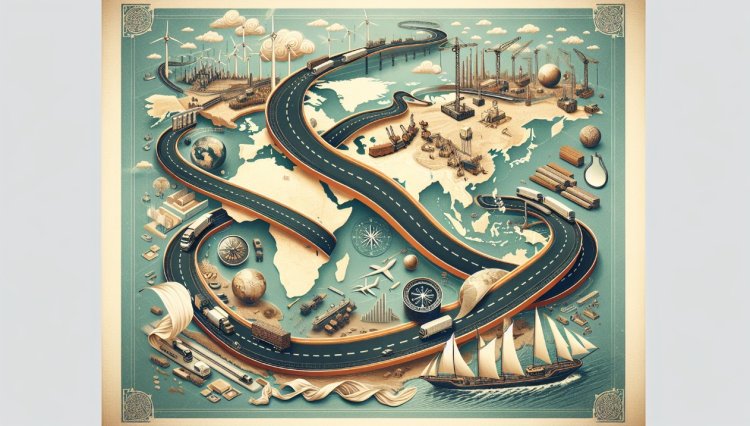The Belt and Road Initiative: China's Global Trade Network
Unveiling China's ambitious global trade network! Explore the Belt and Road Initiative (BRI), its impact on infrastructure, trade, and the reshaping of the global economic landscape.

Connecting the Past with the Future
The Belt and Road Initiative (BRI) is a really big plan to bring back an old trade route called the Silk Road. It wants to make a new network for trading between lots of countries in Asia, the Middle East, and Europe. It's a really important project! The BRI is a plan that China's President Xi Jinping talked about in 2013. It includes many different things, like giving money, doing projects to make more money, and building things like roads and buildings.
The Belt: Overland Routes for Connectivity
The "belt" part of the BRI is like a big road that connects China to other countries in Asia, the Middle East, and Europe. It helps people and goods travel overland between these places. There's a big project happening between China and Pakistan called the China-Pakistan Economic Corridor. They are building lots of things, like power plants that use coal and water, farms that use wind to make electricity, and new roads. They are also making a super-fast train that will connect two cities in Pakistan called Peshawar and Karachi. Just the hallway by itself is expected to cost about $60 billion.
The Road: The Maritime Silk Road for Global Trade
Even though it's called the "road," the BRI actually includes something called the maritime Silk Road. This part of the BRI is about connecting different countries through the sea. It means there are special paths in the sea that connect China to places like Southeast Asia, Africa, and Europe. People use these paths to travel and trade between these countries. China has spent a lot of money to build and own ports in different countries around the world. Some of these countries include Sri Lanka, Dubai, Djibouti, Greece, Spain, and Peru.
Global Reach: 2,600 Projects in Over 100 Countries
The BRI is like a big project that involves lots of things happening in many different countries. More than 2,600 projects are going on, like building roads, bridges, and other important stuff. These projects are happening in over 100 countries around the world. But because we can't see everything clearly, it's hard to know exactly how big and expensive these projects are. However, China made a sizable investment in the BRI.
Trade and Politics: The Dual Objectives of the BRI
The BRI is a big plan that involves trading between different countries. But it's not just about trading things; it's also about the important relationships between countries. China is helping other countries by building things like roads, bridges, and buildings. They are also giving money to help these countries grow their economies. China's way of helping other countries with their economies is different from how Western countries do it. Western countries sometimes ask for certain changes, like making the government more democratic, as a condition for their help. But China doesn't usually ask for these kinds of changes. They have their own unique way of providing economic support.
The World Bank says that the BRI projects can help make over 7 million people who are very poor, not poor anymore. It can also make global trade go up by 6.2%, which means more things are bought and sold between countries. China gives money to many countries, like Djibouti. Djibouti has gotten about $14 billion from China between 2012 and 2020. But sometimes, when people make deals, there can be problems. One problem is corruption, which means some people might do bad things for their own benefit. Another problem is that it's not always clear what's happening in these deals, so it's hard to see what's really going on.
The Debt Trap Debate
Some people are worried that when poor countries borrow money, they might get stuck in a situation where they owe so much that it's really hard for them to pay it back. This is called a "debt trap," and it can be a big problem for those countries. China is like a bank that gives money to other countries for different things they want to do. But sometimes, the countries that borrow the money end up owing too much, and it becomes a big problem for them. Djibouti is a country that owes a lot of money to China. This means that the amount of money they owe is a really big part of all the money their country makes. It's like if you owed your friend a lot of money and it was almost all the money you had. Another example is Sri Lanka, a country where China got control of a big port for a really long time (99 years) because the country had a hard time paying back the money it borrowed.
Some people are saying that the BRI might make countries that receive help from it lose some of their control over their own decisions. But not everyone agrees on this, and some countries don't think the initiative is a bad thing.
Competition and Alternatives
The BRI is like a big project that China is doing to connect different countries together. It has been very successful, and now countries like the United States are paying attention to it. They want to know more about it and maybe even be a part of it. At a big meeting called the G7 summit, some important people came up with a plan called "Build Back a Better World," or B3W for short. B3W is a group that believes in being open and honest, making good decisions, thinking about the environment, and working with businesses. But they haven't told us the exact information yet, like how much money they have or when they plan to do it.
Some people think that the BRI is like a game between China and Western countries. They are trying to see who can do better in terms of trade and influence. But we also need to think about how this could help countries that are still growing. It could give them more options, chances to succeed, and money to support their development. The BRI is like a big bridge that helps countries that need help get the things they need, like money and resources.
Conclusion
The Belt and Road Initiative is like a big plan to connect different countries together. It wants to help these countries grow their economies and make China more important in the world. The BRI is a big project that some people worry about because of money and not being clear about things. But it also gives countries a chance to grow and get important investments that can help them.
Thank you for reading!



 admin
admin 










